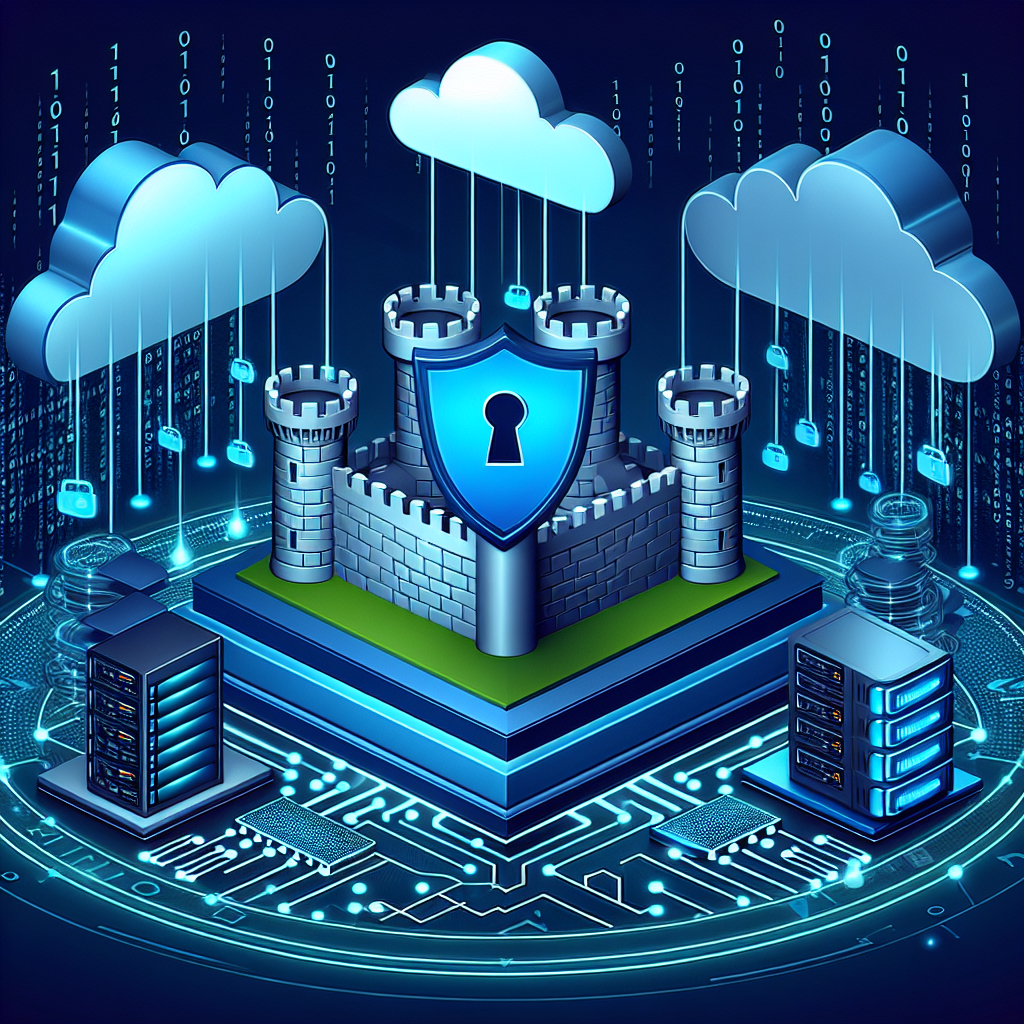Your cart is currently empty!
Tag: Solutions

How IT Solutions are Revolutionizing the Workplace
In recent years, the workplace has undergone a significant transformation thanks to the advancements in Information Technology (IT) solutions. These solutions have revolutionized the way businesses operate, allowing for increased efficiency, productivity, and collaboration among employees. From cloud computing to automation tools, IT solutions have become integral to the modern workplace.One of the most significant ways in which IT solutions have revolutionized the workplace is by enabling remote work. With the rise of cloud computing and collaboration tools such as Slack and Zoom, employees can now work from anywhere in the world. This has not only increased flexibility for employees but has also allowed companies to tap into a global talent pool. Remote work has become even more critical in the wake of the COVID-19 pandemic, as businesses were forced to quickly adapt to a distributed workforce.
IT solutions have also streamlined communication and collaboration within organizations. Email, instant messaging, project management tools, and video conferencing have made it easier for employees to stay connected and work together, regardless of their physical location. This has led to increased productivity and efficiency, as teams can quickly share information and make decisions in real-time.
Automation tools have also played a significant role in revolutionizing the workplace. Tasks that were once time-consuming and labor-intensive can now be automated, freeing up employees to focus on more strategic and creative work. For example, AI-powered chatbots can handle customer inquiries, while robotic process automation can streamline repetitive tasks such as data entry.
Furthermore, IT solutions have revolutionized data management and analytics in the workplace. Businesses can now collect and analyze vast amounts of data to gain insights into customer behavior, market trends, and operational efficiency. This data-driven approach has enabled companies to make more informed decisions and drive business growth.
Overall, IT solutions have transformed the workplace into a more efficient, collaborative, and data-driven environment. As technology continues to evolve, businesses will need to adapt and embrace these solutions to stay competitive in the digital age. By leveraging IT solutions, companies can unlock new opportunities for innovation and growth, ultimately leading to a more productive and successful workplace.

Evaluating the ROI of IT Solutions for Small Businesses
In today’s digital age, small businesses are increasingly relying on technology to streamline operations, improve efficiency, and enhance customer experiences. From cloud computing and cybersecurity to customer relationship management (CRM) systems and e-commerce platforms, there are a plethora of IT solutions available to help small businesses grow and succeed.However, with limited resources and budget constraints, it’s essential for small businesses to carefully evaluate the return on investment (ROI) of implementing IT solutions. While the upfront costs of purchasing and implementing technology can be significant, the long-term benefits can far outweigh the initial investment.
One of the key factors to consider when evaluating the ROI of IT solutions for small businesses is the impact on productivity and efficiency. For example, implementing a cloud-based project management system can help streamline collaboration among team members, reduce the time spent on manual tasks, and improve overall project efficiency. This can result in cost savings, increased productivity, and enhanced profitability for the business.
Another important consideration is the potential for cost savings and revenue generation. For instance, implementing an e-commerce platform can open up new sales channels, expand the customer base, and drive revenue growth. By reaching a wider audience and providing a convenient online shopping experience, small businesses can increase sales and improve their bottom line.
Furthermore, investing in cybersecurity solutions can help small businesses protect sensitive data, prevent cyber attacks, and avoid costly security breaches. By safeguarding customer information and maintaining a secure online environment, businesses can build trust with customers, avoid regulatory fines, and protect their reputation.
When evaluating the ROI of IT solutions, small businesses should also consider the potential for scalability and growth. Investing in flexible and scalable technology that can adapt to the changing needs of the business can help small businesses stay competitive and agile in a fast-paced market. By investing in technology that can grow with the business, small businesses can avoid the need for costly upgrades and replacements down the line.
In conclusion, evaluating the ROI of IT solutions for small businesses is essential for making informed decisions and maximizing the benefits of technology investments. By considering factors such as productivity gains, cost savings, revenue generation, cybersecurity, scalability, and growth potential, small businesses can assess the value of IT solutions and make strategic investments that will drive success and profitability in the long run.

Implementing IT Solutions for Data Security and Compliance
In today’s digital age, data security and compliance are paramount concerns for businesses of all sizes. With the increasing amount of sensitive information being stored and shared online, it is more important than ever to implement robust IT solutions to protect data and ensure regulatory compliance.One of the key challenges businesses face when it comes to data security and compliance is the ever-evolving landscape of threats and regulations. Cyberattacks are becoming increasingly sophisticated, and new regulations such as the GDPR and CCPA are placing stricter requirements on how businesses handle and protect customer data. In order to stay ahead of these challenges, businesses need to invest in IT solutions that are specifically designed to address data security and compliance needs.
There are a number of IT solutions available that can help businesses enhance their data security and compliance efforts. Encryption technologies, for example, can help businesses protect sensitive data by encoding it in a way that only authorized users can access. Multi-factor authentication (MFA) is another important tool that can help businesses prevent unauthorized access to their systems and data.
In addition to these technologies, businesses can also benefit from implementing robust data management solutions that help them track and monitor how data is being used and shared within their organization. Data loss prevention (DLP) solutions, for example, can help businesses prevent sensitive data from being leaked or stolen by monitoring and controlling how data is transferred both internally and externally.
When it comes to compliance, businesses can benefit from implementing IT solutions that help them track and manage their compliance efforts. Compliance management solutions can help businesses automate compliance processes, track compliance requirements, and generate reports to demonstrate compliance to regulators. These solutions can help businesses streamline their compliance efforts and reduce the risk of costly fines and penalties.
Ultimately, implementing IT solutions for data security and compliance is essential for businesses looking to protect their data and ensure regulatory compliance. By investing in the right technologies and solutions, businesses can enhance their security posture, reduce the risk of data breaches, and demonstrate compliance to regulators and customers. As the threat landscape continues to evolve, businesses that prioritize data security and compliance will be better positioned to protect their data and maintain the trust of their customers.

The Role of Technology in Disaster Recovery: Tools and Solutions
In today’s fast-paced world, technology plays a crucial role in disaster recovery efforts. From natural disasters like hurricanes and earthquakes to man-made disasters such as cyberattacks and data breaches, organizations need to be prepared for any eventuality. Technology can provide the tools and solutions needed to ensure a swift and effective recovery in the aftermath of a disaster.One of the key aspects of disaster recovery is data backup and recovery. In the event of a disaster, organizations need to have a backup of their data to ensure that business operations can resume quickly. Cloud storage solutions have become increasingly popular for data backup, as they provide a secure and scalable way to store data offsite. By utilizing cloud storage, organizations can easily restore their data in the event of a disaster, minimizing downtime and ensuring business continuity.
Another important aspect of disaster recovery is communication. During a disaster, communication is key to coordinating response efforts and keeping stakeholders informed. Technology can provide various communication tools, such as messaging apps, video conferencing platforms, and emergency notification systems, to ensure that everyone is on the same page and can quickly respond to the situation at hand.
In addition to data backup and communication tools, technology can also provide solutions for monitoring and assessing the impact of a disaster. For example, remote sensors and monitoring systems can be deployed to track the status of critical infrastructure and assets in real-time. This data can help organizations make informed decisions about resource allocation and response efforts, ultimately speeding up the recovery process.
Furthermore, technology can also play a crucial role in disaster preparedness. By utilizing predictive analytics and risk assessment tools, organizations can identify potential risks and vulnerabilities before a disaster strikes. This information can help organizations develop proactive strategies to mitigate the impact of a disaster and ensure that they are well-prepared to respond effectively.
Overall, technology plays a vital role in disaster recovery efforts by providing the tools and solutions needed to ensure a swift and effective response to any disaster. By leveraging technology, organizations can minimize downtime, protect critical data and assets, and ultimately bounce back stronger in the aftermath of a disaster. As the frequency and severity of disasters continue to increase, it is essential for organizations to embrace technology as a key component of their disaster recovery strategy.

IT Solutions for Remote Workforce Management
In recent years, the concept of remote work has gained popularity among companies and organizations around the world. With advancements in technology, employees now have the ability to work from anywhere, whether it be from home, a co-working space, or even while traveling. However, managing a remote workforce comes with its own set of challenges, such as communication, collaboration, and productivity issues.Luckily, there are a variety of IT solutions available that can help companies effectively manage their remote workforce. These solutions not only streamline communication and collaboration but also ensure that employees remain productive and engaged. Here are some of the top IT solutions for remote workforce management:
1. Communication Tools: One of the most important aspects of managing a remote workforce is effective communication. Tools such as Slack, Microsoft Teams, and Zoom allow employees to easily communicate with their colleagues, share files, and collaborate on projects in real-time. These tools also provide features such as video conferencing, screen sharing, and instant messaging, making it easier for remote team members to stay connected.
2. Project Management Software: To ensure that remote employees stay on track and meet deadlines, project management software such as Asana, Trello, and Monday.com can be incredibly helpful. These tools allow managers to assign tasks, track progress, and monitor project timelines, all in one centralized location. This helps to keep remote teams organized and ensures that everyone is working towards the same goals.
3. Remote Desktop Software: Remote desktop software, such as TeamViewer and LogMeIn, allows employees to access their work computer from anywhere, as if they were sitting in the office. This is especially useful for employees who need to access specific programs or files that are only available on their work computer. Remote desktop software also provides a secure connection, ensuring that sensitive data remains protected.
4. Time Tracking Tools: To monitor the productivity of remote employees, time tracking tools like Toggl and Harvest can be used. These tools allow employees to track their time spent on different tasks and projects, providing insight into where time is being spent and how to improve efficiency. Time tracking tools also help managers to better allocate resources and identify any potential bottlenecks in workflow.
5. Cybersecurity Solutions: With remote work comes an increased risk of cybersecurity threats. To protect sensitive company data and ensure that remote employees are working in a secure environment, cybersecurity solutions such as VPNs, antivirus software, and multi-factor authentication should be implemented. These solutions help to safeguard company information and prevent unauthorized access to sensitive data.
In conclusion, managing a remote workforce can be challenging, but with the right IT solutions in place, companies can effectively manage their remote teams and ensure that employees remain productive and engaged. By utilizing communication tools, project management software, remote desktop software, time tracking tools, and cybersecurity solutions, companies can create a seamless remote work environment that fosters collaboration and productivity. Investing in these IT solutions will not only benefit remote employees but also help companies to stay competitive in today’s digital age.

Maximizing Efficiency with Managed IT Solutions
In today’s fast-paced and technology-driven world, it’s more important than ever for businesses to maximize efficiency in order to stay competitive. One way to achieve this is through the use of managed IT solutions.Managed IT solutions involve outsourcing the management of a company’s IT infrastructure to a third-party provider. This can include services such as network monitoring, data backup and recovery, cybersecurity, and technical support. By partnering with a managed IT provider, businesses can free up their internal IT team to focus on strategic initiatives, while also benefiting from the expertise and resources of an external team.
One of the key benefits of managed IT solutions is the ability to increase efficiency within an organization. By outsourcing routine IT tasks to a dedicated team of experts, businesses can improve the productivity of their employees and reduce downtime caused by technical issues. In addition, managed IT providers can proactively monitor and maintain a company’s IT systems, helping to prevent potential problems before they occur.
Another advantage of managed IT solutions is the cost savings they can provide. By outsourcing IT management to a third-party provider, businesses can eliminate the need to hire and train internal IT staff, as well as invest in expensive hardware and software. Managed IT providers typically offer flexible pricing plans that can be tailored to a company’s specific needs and budget, making it a cost-effective solution for businesses of all sizes.
Furthermore, managed IT solutions can help businesses stay ahead of the curve when it comes to technology. With rapid advancements in IT, it can be challenging for businesses to keep up with the latest trends and innovations. Managed IT providers are constantly updating their skills and knowledge to ensure they are equipped to handle the latest technologies, giving businesses a competitive edge in their industry.
Overall, maximizing efficiency with managed IT solutions is a smart investment for businesses looking to streamline their operations, reduce costs, and stay ahead of the competition. By outsourcing IT management to a third-party provider, businesses can benefit from improved productivity, cost savings, and access to the latest technologies. If you’re looking to take your business to the next level, consider partnering with a managed IT provider today.

The Top Help Desk Software Solutions for Your Business
In today’s fast-paced business environment, it’s crucial for companies to have effective help desk software solutions in place to support their customers and employees. Help desk software allows businesses to streamline their customer support processes, improve response times, and enhance overall customer satisfaction.With so many help desk software options available in the market, it can be overwhelming to choose the right solution for your business. To help you make an informed decision, we’ve compiled a list of the top help desk software solutions that are trusted by businesses of all sizes.
1. Zendesk: Zendesk is a popular help desk software solution that offers a wide range of features, including ticket management, live chat support, and knowledge base management. With Zendesk, businesses can easily track customer issues, prioritize tasks, and collaborate with team members to resolve problems quickly and efficiently.
2. Freshdesk: Freshdesk is another leading help desk software solution that is known for its user-friendly interface and robust features. With Freshdesk, businesses can automate ticket routing, set up SLA policies, and analyze customer feedback to improve their support processes. Freshdesk also offers integration with popular third-party tools, such as CRM systems and social media platforms.
3. Intercom: Intercom is a customer messaging platform that offers a help desk software solution to support businesses in managing customer inquiries across multiple channels, including email, chat, and social media. With Intercom, businesses can create personalized responses, track customer interactions, and provide proactive support to their customers.
4. Jira Service Management: Jira Service Management is a help desk software solution that is designed for IT teams to manage incidents, problems, and changes effectively. With Jira Service Management, businesses can centralize their IT support operations, automate repetitive tasks, and improve collaboration between different teams within the organization.
5. HubSpot Service Hub: HubSpot Service Hub is a comprehensive help desk software solution that is part of the popular HubSpot CRM platform. With HubSpot Service Hub, businesses can manage customer inquiries, create knowledge base articles, and track customer satisfaction metrics. HubSpot Service Hub also offers integration with other HubSpot tools, such as marketing automation and sales CRM.
In conclusion, investing in a reliable help desk software solution is essential for businesses to deliver exceptional customer support and streamline their internal operations. The top help desk software solutions mentioned above offer a range of features and benefits to help businesses of all sizes improve their support processes and enhance customer satisfaction. Consider evaluating these solutions to find the one that best fits your business needs and budget.

The Importance of Cybersecurity in IT Solutions
In today’s digital age, the importance of cybersecurity in IT solutions cannot be overstated. With the increasing reliance on technology for business operations, communication, and data storage, the threat of cyberattacks has become a major concern for organizations of all sizes. It is crucial for businesses to prioritize cybersecurity measures to protect their sensitive information, maintain the trust of their customers, and safeguard their reputation.Cybersecurity refers to the practice of protecting computer systems, networks, and data from malicious attacks, unauthorized access, and other cyber threats. This includes implementing measures such as firewalls, encryption, multi-factor authentication, and regular security audits to ensure that sensitive information is safe from hackers and cybercriminals.
One of the key reasons why cybersecurity is essential in IT solutions is to prevent data breaches. Data breaches can have devastating consequences for businesses, leading to financial losses, damage to reputation, and legal repercussions. By implementing robust cybersecurity measures, organizations can minimize the risk of data breaches and protect their valuable information from falling into the wrong hands.
Additionally, cybersecurity is important for ensuring compliance with regulations and standards. Many industries have strict regulatory requirements for data protection, such as the Health Insurance Portability and Accountability Act (HIPAA) for healthcare organizations and the General Data Protection Regulation (GDPR) for businesses operating in the European Union. Failure to comply with these regulations can result in hefty fines and penalties, making cybersecurity a critical aspect of IT solutions.
Moreover, cybersecurity is crucial for maintaining the trust of customers and stakeholders. In today’s digital world, consumers are increasingly concerned about the security of their personal information, and a data breach can erode trust and loyalty in a business. By prioritizing cybersecurity, organizations can demonstrate their commitment to protecting customer data and maintaining a secure environment for transactions and communication.
In conclusion, the importance of cybersecurity in IT solutions cannot be ignored. It is essential for businesses to invest in cybersecurity measures to protect their sensitive information, prevent data breaches, comply with regulations, and maintain the trust of their customers. By prioritizing cybersecurity, organizations can mitigate the risks associated with cyber threats and safeguard their reputation in an increasingly digital world.

10 IT Solutions Every Business Needs in 2021
In today’s digital age, having the right IT solutions in place is crucial for the success of any business. With technology constantly evolving, it can be challenging to keep up with the latest trends and tools that can help streamline operations and improve efficiency. In 2021, there are 10 IT solutions that every business should consider implementing to stay ahead of the competition.1. Cloud Computing
Cloud computing has become a staple in the business world, allowing companies to store, manage, and access data and applications over the internet. By moving to the cloud, businesses can reduce costs, increase flexibility, and improve collaboration among employees.
2. Cybersecurity
With cyber threats becoming more sophisticated, investing in cybersecurity solutions is essential to protect sensitive data and prevent cyber attacks. Implementing firewalls, antivirus software, and encryption tools can help safeguard your business from potential security breaches.
3. Remote Work Solutions
The COVID-19 pandemic has forced many businesses to adopt remote work policies, making it crucial to have the right tools in place to support a remote workforce. Video conferencing tools, collaboration platforms, and virtual private networks (VPNs) are essential for facilitating communication and collaboration among remote employees.
4. Data Analytics
Data analytics tools can help businesses make informed decisions by analyzing and interpreting data to identify trends and patterns. By leveraging data analytics, businesses can gain valuable insights into customer behavior, market trends, and operational performance.
5. Customer Relationship Management (CRM) Software
CRM software is essential for managing customer relationships and improving customer satisfaction. By centralizing customer data and tracking interactions, businesses can better understand their customers’ needs and preferences, leading to improved customer retention and loyalty.
6. Enterprise Resource Planning (ERP) Systems
ERP systems integrate key business processes such as finance, human resources, and supply chain management into a single platform, streamlining operations and improving efficiency. By implementing an ERP system, businesses can reduce manual processes and improve decision-making.
7. Mobile Device Management (MDM)
With the rise of mobile devices in the workplace, businesses need to implement mobile device management solutions to secure and manage company-owned and employee-owned devices. MDM solutions can help enforce security policies, track device usage, and remotely wipe data in case of loss or theft.
8. Business Intelligence Tools
Business intelligence tools help businesses analyze and visualize data to gain insights into their operations and make data-driven decisions. By using business intelligence tools, businesses can monitor key performance indicators, track progress towards goals, and identify areas for improvement.
9. VoIP Phone Systems
Voice over Internet Protocol (VoIP) phone systems allow businesses to make and receive calls over the internet, reducing costs and improving communication efficiency. VoIP phone systems also offer advanced features such as call forwarding, voicemail to email, and conference calling.
10. IT Help Desk Software
IT help desk software is essential for managing and resolving IT issues efficiently. By implementing help desk software, businesses can streamline ticketing, track issue resolution, and provide timely support to employees and customers.
In conclusion, investing in the right IT solutions can help businesses stay competitive and adapt to the ever-changing technological landscape. By implementing cloud computing, cybersecurity, remote work solutions, data analytics, CRM software, ERP systems, MDM, business intelligence tools, VoIP phone systems, and IT help desk software, businesses can improve productivity, enhance security, and drive growth in 2021 and beyond.

The Top Data Backup and Recovery Solutions for Small Businesses
Data backup and recovery is a critical aspect of running a successful small business. Whether it’s due to a hardware failure, human error, or a cyber-attack, losing important data can be devastating for a company. That’s why it’s essential for small businesses to have a reliable data backup and recovery solution in place.Here are some of the top data backup and recovery solutions that small businesses can consider:
1. Cloud Backup Services:
Cloud backup services like Dropbox, Google Drive, and OneDrive offer small businesses an easy and affordable way to back up their data. These services automatically sync files to the cloud, ensuring that data is always accessible and secure. Additionally, cloud backup services offer features like file versioning and encryption, providing an extra layer of protection for sensitive information.
2. External Hard Drives:
External hard drives are a popular backup solution for small businesses due to their affordability and ease of use. By connecting an external hard drive to a computer, businesses can quickly back up important files and folders. However, it’s important to remember that external hard drives can fail, so it’s essential to have multiple backups in place.
3. Network-Attached Storage (NAS):
NAS devices are a great option for small businesses that require a more robust backup solution. These devices connect to a network and allow multiple users to access and back up data. NAS devices offer features like RAID (redundant array of independent disks) for data protection and remote access capabilities for added convenience.
4. Backup Software:
Backup software like Acronis, Carbonite, and Backblaze offer small businesses a comprehensive backup solution. These tools allow businesses to schedule automatic backups, perform full system backups, and easily recover data in the event of a disaster. Backup software also often includes features like encryption and compression to help protect and optimize data storage.
5. Disaster Recovery Services:
For small businesses that require a more comprehensive backup and recovery solution, disaster recovery services like Datto and Zerto offer peace of mind. These services provide real-time data replication, failover capabilities, and rapid recovery options in the event of a disaster. While these services may be more costly, they provide an extra layer of protection for businesses that cannot afford to lose critical data.
In conclusion, data backup and recovery are essential for the success of any small business. By investing in a reliable backup solution, businesses can protect their data and minimize the risk of downtime in the event of a disaster. Whether it’s through cloud backup services, external hard drives, NAS devices, backup software, or disaster recovery services, small businesses have a variety of options to choose from to ensure their data is safe and secure.
